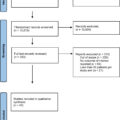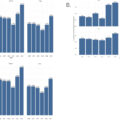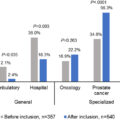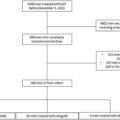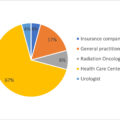Highlights
- •
Controversy remains regarding adjuvant therapy (AT) in patients treated with neoadjuvant chemotherapy (NAC) and radical cystectomy (RC) for muscle-invasive bladder cancer.
- •
Determining variables that may affect cancer-specific survival (CSS) for nonresponsiveness to NAC may aid in identifying patients who may require AT after RC.
- •
In this multicentric retrospective study, only ypN status was shown to be an independent prognostic indicator of CSS in patients who did not respond to NAC.
- •
ypN+ may be an important prognostic indicator that should be evaluated and may favor AT when considering AT or observation options for locally advanced disease in NAC-non-responsive patients.
Abstract
Objective
To investigate the risk factors affecting cancer-specific survival (CSS) in nonresponsive disease to neoadjuvant chemotherapy (NAC) among patients with muscle-invasive bladder cancer (MIBC) who were treated with NAC and radical cystectomy (RC).
Methods
Patients with MIBC who underwent NAC and RC were retrospectively examined. By comparing clinical and pathological stages, patients whose pathological stage was lower than clinical stage were categorized as “NAC-responsive” and the remainder as “NAC-non-responsive.” Apart from pathologic staging, variables compared between groups included age, gender, Eastern Cooperative Oncology Group (ECOG) score, clinical stages, NAC type and cycle number, durations between MIBC diagnosis and NAC initiation and RC, presence of hydronephrosis, number of lymph nodes removed, and variant histology of urothelial bladder cancer. CSS analysis was performed by construction of Kaplan–Meier survival curves and multivariable Cox regression was performed to identify the prognosticators in the NAC-non-responsive-group.
Results
Ninety-two patients were included with a mean age was 61.5 ± 8.5 years, of whom 84.8% were men. The NAC regimen used was predominantly gemcitabine-cisplatin (88%) and the median cycle number was 4. Fifty-six (60.9%) patients were NAC-non-responsive. There was a significantly lower proportion of patients receiving ≥4 cycles (46.4% vs. 66.7%) and a higher rate of patients with ECOG score ˃1 (33.9% vs. 11.1%) in the NAC-non-responsive-group compared to the NAC-responsive-group (both P < 0.05). Other variables were similar between groups. In multivariable analysis, only ypN+ was found to be an independent prognosticator for CSS in NAC-non-responsive-group (HR: 2.725, CI95%:1.017–7.303).
Conclusion
Although higher ECOG scores and lower cycle numbers appears to be associated factors in NAC-non-responsive disease, only ypN(+) status was a prognosticator for CSS in this population.
1
Introduction
There is as much as 16% overall survival advantage in patients with nonmetastatic muscle-invasive bladder cancer (MIBC) who are treated with neoadjuvant chemotherapy (NAC) [ ]. Therefore, current guidelines recommend NAC followed by radical cystectomy (RC) and pelvic lymph node resection (PLND) for the management of nonmetastatic MIBC [ , ]. Although it is known that having a pathological response in patients receiving NAC is associated with good oncological outcomes [ ] in some patients pathological response does not occur [ ]. Pathological nonresponsiveness may lead to a delay in definitive treatment in patients with MIBC receiving NAC, and may predispose poorer oncological outcomes. Various reports have shown that pathological downstaging rates may be as high as 60% after NAC [ , ]. However, patients who are nonresponsive to NAC should be assumed as having chemotherapy-resistant disease, and they may be suitable candidates for new clinical trials, such as molecular targeted therapies.
Most of the published studies have focused on factors associated with survival advantages of NAC treatment in the management of MIBC, whereas few studies have investigated the factors that will affect survival in case of nonresponse to NAC [ , ]. NAC-non-responsive patients consist of those with ≥ypT2N0 and, currently, there is still a controversy about whether to recommend adjuvant treatment to the patients with ≥ypT2N0 disease after NAC followed by RC [ ].
We sought to determine the differences between NAC response and nonresponse in patients who were treated with NAC, RC, and PLND for the treatment of MIBC in the Turkish patient population, and to investigate the factors that affect cancer-specific survival (CSS), in NAC-non-responsive patients.
2
Methods
2.1
Data collection
Patients with cT2-4a/N0-1/M0 who received NAC and subsequently underwent RC and PLND between 2005 and 2022 for MIBC and whose records were present in the Turkish Urooncology Association Bladder Cancer Database were retrospectively reviewed. Demographics, clinical, surgical, pathological, and oncological data were collected. Demographics and clinical data consisted of age at RC, gender, Eastern Cooperative Oncology Group (ECOG) score, clinical stage before NAC (cross-sectional imaging and pathological results of Transurethral Resection of Bladder Tumor), NAC type used, number of NAC cycles, duration from diagnosis of MIBC to initiation of NAC treatment, time from diagnosis of MIBC to RC, and presence of hydronephrosis of any renal unit. Surgical margin status, histologic variants of urothelial bladder cancer and number of lymph nodes removed as well as pT stage were the surgical and pathological data extracted. Histopathological examinations were evaluated according to the 2016 World Health Organization classification. In terms of oncological data, death from any cause, cancer-specific death, and the use of Adjuvant chemo-, immuno-, or radio-Therapy (AT) were obtained. Those with missing data including more than 1 variable of demographics, clinical, surgical, pathological, and oncological data, those with an oncological follow-up period of less than 3 months, and those with nonurothelial tumor biology were not included in the study. By comparing the stages based on clinical and pathological staging, patients whose pathological stage was lower than the clinical stage (from the locally advanced stage [˃cT2N0] to localized muscle-invasive [ypT2N0] or lower-stage disease [˂ypT2N0]; from the local muscle-invasive disease [cT2N0] to nonmuscle-invasive disease [ypT a-CIS-1 N0] or complete response [ypT0N0]) were classified as “NAC-responsive,” those whose pathological stage was stable or more advanced than the clinical stage were categorized as “NAC-non-responsive.”
In order to define any variables that may differ between NAC-responsive and NAC-non-responsive disease, clinical, demographic, surgical-pathological, and oncological outcomes were compared as a first step. Then, univariable and multivariable regression survival analysis was used to determine demographics, clinical, surgical, and pathological variables that may affect CSS in the “NAC-non-responsive” group. In the “NAC-non-responsive” group, patients were also stratified based on localized disease (ypT2N0) and locally advanced disease (ypT3-4aN0 or ypTanyN+) to investigate if this affected CSS. Ultimately, the impact of prognostic factor(s) that were defined from multivariable analysis for CSS in NAC-non-responsive group was assessed in terms of both the AT and the observation strategy in patients with locally advanced disease after NAC, RC, and PLND using survival curves. Ethical approval was obtained for this study (GOKAEK-2024/148).
2.2
Statistics
Nonparametric and parametric variables are expressed as median (Interquartile range [IQR]: 25%–75%) and mean ± standard deviation (SD). Categorical variables were compared using the Chi-square test. CSS-based regression analysis for nonresponders to NAC was performed by Cox regression analysis adjusting for age, gender, ECOG score, number of NAC cycles, duration from diagnosis of MIBC to initiation of NAC treatment, duration between diagnosis of MIBC and RC, hydronephrosis of any renal unit, ypT stage, and ypN status using the enter method. In order to minimize the risk of bias, it was ensured that the multivariable model did not exceed ‘‘10 events per variable’’ in the CSS setting [ , ] Kaplan–Meier curves were constructed in the comparison groups for survival analysis. A p ˂0.05 level was considered statistically significant in this study.
3
Results
Database records revealed 192 patients treated with NAC followed by RC and PLND, 92 patients met the inclusion criteria and were included in the study ( Flowchart in Supplementary Fig. 1 ). The mean age of the included patients was 61.5 ± 8.5 years and 84.8% were males. The predominant NAC regimen used in 88% of patients (81/92) was gemcitabine plus cisplatin (GC) and the median number of cycles was 4 (3–4). The median ECOG score was 1 (0–2). The time from diagnosis to the first course of NAC and the time from diagnosis to RC was 36 (21–64) and 157 (122–219) days, respectively. Of the patients, 32.6% had clinically locally advanced MIBC (17 and 13 patients were diagnosed with cT3-4N0 and cTanyN+ disease, respectively). The median number of lymph nodes removed during RC was 15 (11–20) and the median number of metastatic lymph nodes was 2 (1.25–4.75). The incidence of variant histology of urothelial bladder cancer was 26% (25 of 96 patients). When patients were evaluated according to NAC response status, 39.1% of the patients (n = 36) were NAC-responsive. Of the NAC-responsive patients, 4 (11.1%) were from cT2N0 to ypT1-CIS-aN0, 19 patients (52.8%) were cT2N0 to ypT0N0, and 13 patients (36.1%) were from clinical locally advanced disease to ≤ypT2N0. Of the NAC-non-responsive patients, 25 (44.6%) were from cT2N0 to ypT3-4N0/ ypTanyN+ disease, 17 (30.4%) remained as locally advanced disease after NAC treatment, and 14 (25%) were T2N0 in both clinical (cT2N0) and pathological (ypT2N0) staging. Clinical lymph node involvement was 8 (22.2%) and 5 (8.9%) for the NAC-responsive patients and the NAC-non-responsive patients, respectively. ypN+ patients consisted of 1 patient for ypT0N+, 3 patients for ypT2N+, 9 patients for ypT3N+, and 8 patients for ypT4aN+. Additionally, in ypN+ patients, only 2 were cN+ before NAC. The average follow-up period after cystectomy was 19 (7–40) months. The rate of death of any cause was significantly higher (13.9% vs. 42.9%, P < 0.05) but the rate of cancer-specific deaths was not significantly (13.9% vs. 30.4%, P = 0.07) higher in the “NAC-non-responsive” patients compared to the “NAC-responsive” group in the follow-up. Positive surgical margins were only encountered in NAC-nonresponsive group (6 of 56 patients, 10.7%). The rate of patients receiving ≥4 cycles of NAC was significantly lower in the “NAC-non-responsive” group compared to the “NAC-responsive” group (46.4% vs. 66.7%, P < 0.05). The NAC-non-responsive group had received a median of 3 (2–4) NAC cycles, whereas this was 4 (3–5) in the NAC-responsive group. In the “NAC-non-responsive” group, the proportion of patients with ECOG scores >1 was significantly higher (33.9% vs. 11.1%, P < 0.05) compared to the NAC-responsive group, but there was no other significant differences between the groups in terms of other variables ( P > 0.05, Table 1 ).
| NAC-responsive (n = 36) | NAC-non-responsive (n = 56) | P a | |
|---|---|---|---|
| Age (years), n (%) ≤61 >61 | 18 (50) 18 (50) | 25 (44.6) 31 (55.4) | 0.672 |
| Gender, n (%) Male Female | 29 (80.6) 7 (19.4) | 49 (87.5) 7 (12.5) | 0.365 |
| ECOG score, n(%) 0–1 ≥2 Missing data | 31 (86.1) 4 (11.1) 1 (2.8) | 37 (66.1) 19 (33.9) – | 0.016 |
| Clinical stage cT 2 N0 cT 3 N0 cT 4 N0 cT any N+ | 23 (63.9) 3 (8.3) 2 (5.6) 8 (22.2) | 39 (69.6) 10 (17.9) 2 (3.6) 5 (8.9) | 0.217 |
| NAC type used, n(%) Gemcitabine plus cisplatin Other cisplatin regimens Gemcitabine plus carboplatin Missing data | 31 (86.1) 2 (5.6) 2 (5.6) 1 (2.7) | 51 (91.1) 2 (3.6) 3 (5.4) – | 0.326 |
| Number of NAC cycles b , n (%) ≤3 ≥4 Missing data | 11 (30.5) 24 (66.7) 1 (2.8) | 30 (53.6) 26 (46.4) – | 0.039 |
| Duration from diagnosis of MIBC to initation of NAC treatment (day), n (%) <36 ≥36 Missing data | 19 (52.8) 16 (44.4) 1 (2.8) | 25 (44.6) 30 (53.6) 1(1.8) | 0.414 |
| Duration between diagnosis of MIBC and RC (day), n (%) ≤156 >156 Missing data | 20 (55.6) 16 (44.4) – | 25 (44.6) 30 (53.6) 1 (1.8) | 0.346 |
| Hydronephrosis of any renal unit, n (%) Yok Var | 30 (80) 6 (20) | 38 (67.9) 18 (32.1) | 0.099 |
| Surgical margin status, n (%) Negative Positive | 36 (100) – | 50 (89.3) 6 (10.7) | 0.042 |
| Number of lymph nodes removed, n (%) <15 ≥15 | 19 (52.8) 17 (47.2) | 25 (44.6) 31 (55.4) | 0.446 |
| Pathological stage, n (%) ypT 0 N0 ypT a-CIS-1 N0 ypT2N0 ypT 3-4 N0 ypT any N+ | 23 (63.9) 6 (16.7) 7 (19.4) – – | – – 14 (25) 21 (37.5) 21 (37.5) | ˂0.001 |
| Histologic variants of urothelial bladder cancer in RC specimen Absence Squamous Glandular Sarcomatoid Trophoblastic Micropapillary Nested | 28 (77.8) 5 (13.9) – 1 (2.8) – 1 (2.8) 1 (2.8) | 39 (69.6) 10 (17.9) 3 (5.4) 3 (5.4) 1 (1.8) 0 0 | 0.377 |
| Death, n (%) | 5 (13.9) | 24 (42.9) | 0.004 |
| Cancer specific death, n (%) | 5 (13.9) | 17 (30.4) | 0.071 |
Stay updated, free articles. Join our Telegram channel

Full access? Get Clinical Tree



